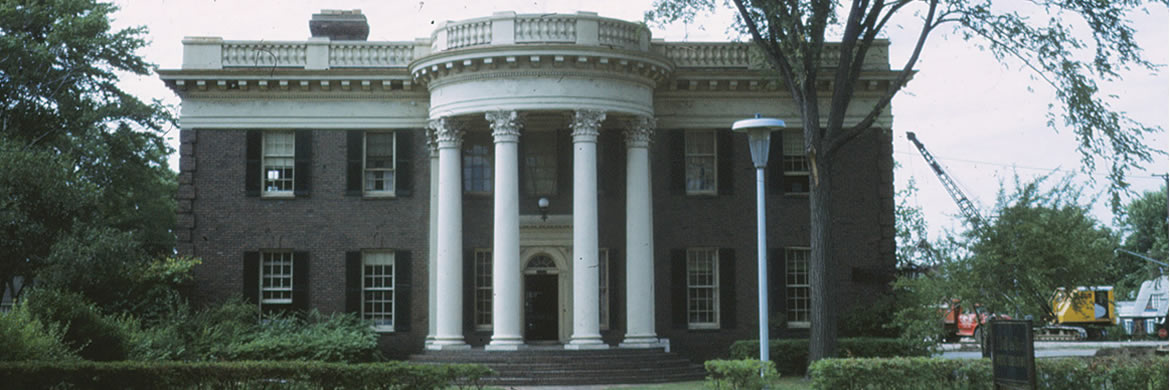
Flint and Genesee County, Michigan and Beyond
Every house has history. Researching the history of your house can be fascinating, but also very challenging and time consuming.
There are many resources at the Flint Public Library and online that can provide information about your house, ranging from city directories to architectural styles to property tax records. There are many books in the Flint Public Library's collection that can help you in researching your house's history. Search our catalog or contact us for research advice.
To construct a complete house history, you usually have to consult a variety of sources. The following list of sources will help you get started on your research.
Maps and Aerial Photographs in the Library
The Sanborn Map company drew insurance maps for many cities around the country, including Flint. The maps include lot outlines and the original shape of any structures on the property, color-coded to indicate building material. In some maps, changes are pasted over the original. The Flint Public Library has Sanborn Fire Insurance Maps on film for the cities of Flint, Clio, Davison, Fenton and Flushing. Not all areas of the city are covered by the Sanborn maps. The maps can be used to trace a house's history or the development of a neighborhood or subdivision.
A phenomena of the nineteenth century, many communities were represented in "bird's eye views" drawn maps. The companies that were contracted to make these views prided themselves in representing the town with great accuracy. If your home was built prior to the publication of a bird's-eye view, the print can make a useful, if quite small, image of your home. Central Michigan University and the Library of Congress have collections of these, some of which are viewable online.
Plat maps were originally used to document property ownership, and are now a valuable resource in researching house history. A typical plat book is published by county with a map printed for each township. The township is then further subdivided to indicate property ownership. Flint Public Library has plat maps for Genesee County.
Street maps will help you locate certain streets and determine if the street name or location has changed over time. The Flint Public Library has street maps of Flint and the surrounding area for a variety of years.
Aerial photographs show a photograph of the actual dwelling from a bird's eye view. The Flint Public Library has aerial photographs of the city of Flint from 1971.
Histories
County Histories solicited paid subscriptions from the affluent citizens of the area. The amount of information included about each individual depended on the fee paid. Biographical statements, portraits and possibly an image of the residence could be included. Usually only the most prominent houses were included in the county histories. In some instances, the county histories were combined with the plat maps. The Flint Public Library has county histories for Genesee County, as well as many other Michigan counties.
City Directories, published by R. L. Polk and company, list residents who live in dwellings within a community. The listings are arranged by name or address, and sometimes list the occupation of the resident(s). City directories can be used to determine who lived at a certain address in a certain year. The Flint Public Library has city directories for Flint and surrounding communities from the 1890's to present day.
Compiled by Flint Public Library Staff, the Historic Homes Binder contains information about elected historic homes in Genesee County. It contains the following information for each home, if available: name, location, previous use of site, owner(s), tenants, when built, architect, when moved, when razed, pictures/photos, uses of building, description of building, additions/remodeling, disasters and legends. Very few homes are included in the historic homes binder.
The Genesee County Biography File is an index of biographical information for individuals in the Genesee County area. Sources indexed are the Flint Journal, various County Histories and local history clippings. Use the biography file to locate information on the people who lived in your house.
Beginning in 1880, the United States Census began including the addresses of the individuals recorded. Numerous other details were also recorded, including occupation, age, ancestry, etc. Use the census to discover who lived in your house, as well as the surrounding neighborhood. For a list of all census questions, see:
https://www.census.gov/history/www/through_the_decades/index_of_questions/
Local Resources
The Register of Deeds is the county official responsible for recording property ownership. The deed to a property can reveal who owned your house and when. To search for a deed, you will need the name of the grantor or grantee. To locate this information, contact your local assessor or treasurer's office. Some records can also be located using the property tax identification number or the street address. You can search the holdings of the Register of Deeds Office via their website, located at https://www.geneseecountymi.gov/departments/register_of_deeds/index.php, or you can visit the office in person. There is a charge of $1.00 per copy.
Genesee County Register of Deeds Office
https://www.geneseecountymi.gov/departments/register_of_deeds/index.php
Room 138 Administration Bldg
1101 Beach Street
Flint, MI 48502
(810) 257-3060
Property Tax Records may help you determine who lived in your house, and may also provide a description of the property. The records are located in a number of different places. The Genesee County Treasurer's Office has microfilm copies of property tax records. The original records may be located in one of two places - The Perry Archives https://sloanlongway.org/about-perry-archives/ in the Sloan Museum’s Buick Gallery or in your local Treasurer's Office.
Genesee County Treasurer's Office
https://www.gc4me.com/departments/treasurer_s/index.php
1101 Beach Street
Flint, MI 48502
(810) 257-3059